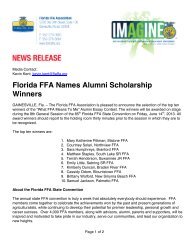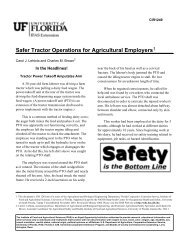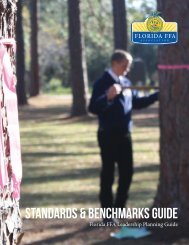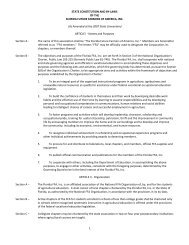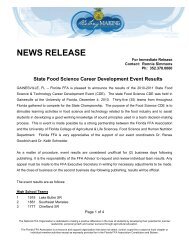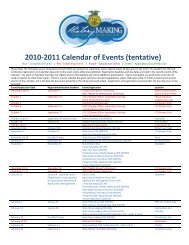CDE Handbook - Florida FFA Association
CDE Handbook - Florida FFA Association
CDE Handbook - Florida FFA Association
You also want an ePaper? Increase the reach of your titles
YUMPU automatically turns print PDFs into web optimized ePapers that Google loves.
Environmental Science and Natural Resources <strong>CDE</strong><br />
Annual Practicums<br />
Students will participate in the following two areas on an annual<br />
basis:<br />
Press Release Writing<br />
1. Participants will be furnished access to computers, or<br />
similar equipment, on which to create a written document.<br />
(In the event electronic equipment is not available pencils/<br />
pens will be provided.)<br />
2. Participants will create a written document, 350 words or<br />
less in the style of a news/press release.<br />
3. Press release should contain the basic elements (facts)<br />
customarily found in written publications (who, what,<br />
where, when and how). The elements/facts presented are<br />
to reflect the thoughts of the participant in relation to the<br />
topic being addressed.<br />
4. Examples<br />
– What type of change is being proposed?<br />
– Does the proposed solution reflect an economic,<br />
or natural resource, impact on surrounding<br />
communities?<br />
– Have participants clearly stated the outlined<br />
problem and a solution?<br />
– Does the press release outline and explain the<br />
problem in a clear manner? (I.e.: could someone<br />
from outside the competition or <strong>FFA</strong> arena read<br />
the release and understand the problem and<br />
proposed solution)?<br />
Identification<br />
Students will identify fifty (50) items from the following<br />
combined areas:<br />
Equipment Reptiles/Amphibians<br />
Plants Predators<br />
Wildlife Birds<br />
Fish Non-Native Species<br />
Rotational Practicums<br />
Students will participate in three of the following practicums each<br />
year. Practicums may vary from year to year.<br />
Water Analysis<br />
Using measuring devices, each participant will measure a sample of<br />
water for quality analysis and contaminants.<br />
• Analyze the results of measurements.<br />
• Name possible causes of the particulate or other contaminant:<br />
• Are they natural<br />
• Are they pollutants (what level is acceptable)<br />
48<br />
<strong>Florida</strong> <strong>FFA</strong> Career Development Event <strong>Handbook</strong><br />
• Describe the effects on the environment of the polluntants.<br />
• List the sources of the pollutants.<br />
• Discuss ways the water quality can be improved.<br />
Soil Nutrient Test<br />
Students will be furnished with a sample of soil and test kit.<br />
They will have to determine the current levels of:<br />
Nitrogen pH<br />
Potassium Phosphorus<br />
Students will use this information along with an extension<br />
service crop sheet provided to make suggestions for what<br />
fertilizers need to be added to grow a given crop. (Example of<br />
crops, corn, wheat, tobacco, soybeans)<br />
GPS Locations<br />
Students will be furnished with a Global Positioning System<br />
(GPS) unit and a map with points identified in longitude and<br />
latitude.<br />
Using the GPS unit, the participant will be required to walk to<br />
and locate the points.<br />
Participants will then record a predetermined identification<br />
mark located at each point.<br />
Participants shall know how to read longitude and latitude<br />
numbers, how to use a GPS unit and understand differential<br />
corrections.<br />
Environmental Analysis<br />
Students will address the following five aspects:<br />
• Living Organisms – students will identify and list as<br />
many living organisms (both native and invader) as<br />
they can find within the marked boundaries of the site.<br />
Additional species may be artificially introduced as<br />
mounted or preserved specimens.<br />
• Non-living components (shelter, nutrients) – students<br />
will inventory resources such as water, shelter, etc. upon<br />
which resident species depend for survival.<br />
• Food Web – students will define relationships among<br />
the plants and animal species that are found or<br />
introduced in the study area.<br />
• Ecological Succession – students will identify the stages<br />
of succession of various grasses, shrubs and trees.<br />
They will also identify causes of changes in succession<br />
patterns.<br />
• Situation Analysis – Students will determine whether a<br />
healthy balance exists between the environment and the<br />
native species that depend upon it. They will also check<br />
remediation practices where needed.



